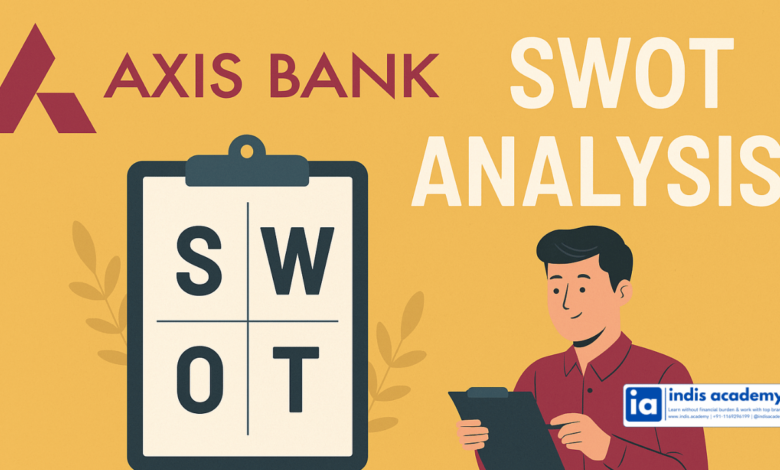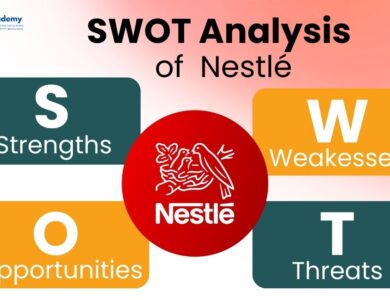In-Depth SWOT Analysis of Axis Bank – India’s Leading Private Sector Bank

In the fast-evolving landscape of India’s banking sector, Axis Bank has established itself as one of the top players in the private banking space. From its humble beginnings as UTI Bank in 1993 to becoming India’s third-largest private sector bank today, Axis Bank’s journey reflects its adaptability, growth, and strategic foresight.
As the financial industry faces new challenges and opportunities—especially with the rise of digital banking, fintech innovations, and regulatory shifts—Axis Bank continues to transform its services and expand its reach across the globe.
Known for its strong retail banking, wealth management services, and a growing digital presence, Axis Bank is at a critical juncture where understanding its strengths, weaknesses, opportunities, and threats is vital to gauge its future trajectory.
In this article, we’ll conduct an in-depth SWOT analysis of Axis Bank, exploring how it leverages its competitive advantages while navigating the challenges in an ever-competitive market. From its digital transformation journey to managing non-performing assets (NPAs), this SWOT breakdown will provide key insights into the bank’s strategy and outlook for the future.
Learn AI & Digital Marketing,
Pay Fees After Placement
- ✅ Minimal Admission Fees
- ✅ No Loan or Income Sharing Agreement
- ✅ 100% Placement Support
- ✅ ISO & Govt Registered Certificate
- ✅ Practical 3+1 Months Duration
Get a free counseling call. We’ll guide you through learning, certification, and job placement.
Request a Free Call Back
Takes less than a minute.
Company Overview – About Axis Bank
Axis Bank, founded in 1993 as UTI Bank, is one of India’s largest private sector banks by assets and market share. Headquartered in Mumbai, it offers a wide range of financial products and services including retail banking, corporate banking, wealth management, and investment banking.
Axis Bank has become a key player in India’s financial ecosystem with a solid reputation for customer-centric services, technological innovation, and global expansion.
The bank operates through over 4,500 branches and 12,000 ATMs across India, providing comprehensive banking solutions to over 40 million customers. With a strong focus on digital banking and financial inclusion, Axis Bank has also made significant strides in enhancing its online platforms and mobile banking solutions, serving a growing tech-savvy population.
Additionally, the bank has expanded its presence in global markets, including Southeast Asia, the Middle East, and North America, allowing it to tap into international growth opportunities.
Axis Bank is known for innovative products, such as Axis Pay (its UPI-based mobile app) and instant loan offerings, aimed at making banking more accessible and customer-friendly.
🔄 Axis Bank vs Competitors: Key Comparison
| Company | Key Products | Market Focus | Global Presence |
|---|---|---|---|
| Axis Bank | Retail banking, loans, wealth management | Private sector banking | Strong in India, limited global reach |
| HDFC Bank | Retail banking, SME, digital services | Leading private bank | Strong in India and globally present |
| ICICI Bank | Corporate and retail banking | Comprehensive banking | Extensive global network |
| Kotak Mahindra | Banking, investment services | Wealth management, retail banking | Primarily India-focused |
| State Bank of India (SBI) | Banking, financial services | Public sector banking | Strong national presence, limited global |
What is SWOT Analysis?
A SWOT analysis is a strategic tool used to evaluate a company’s current position in the market by analyzing its internal strengths and weaknesses alongside external opportunities and threats. This framework helps companies understand where they stand and how they can capitalize on their strengths, mitigate weaknesses, seize opportunities, and defend against threats.
Here’s a quick breakdown of the four components of a SWOT analysis:
- S – Strengths: The internal factors that give the company a competitive advantage. These could include brand reputation, innovation, financial stability, or customer loyalty.
- W – Weaknesses: Internal limitations or areas where the company falls short compared to competitors. These could be operational inefficiencies, high costs, or reliance on a limited customer base.
- O – Opportunities: External trends, technologies, or market conditions the company can leverage to grow or innovate. This could include emerging markets, technological advancements, or regulatory changes that favor the company.
- T – Threats: External challenges or risks that could negatively impact the company. These might include economic downturns, increased competition, or changing regulations.
For a complex organization like Axis Bank, conducting a SWOT analysis is critical to understanding how the bank can navigate the rapidly changing financial landscape in India and internationally.
By analyzing the internal and external factors, Axis Bank can better position itself to sustain growth, maintain competitiveness, and stay ahead of market disruptions.
Axis Bank’s Strengths
Axis Bank has carved out a significant position for itself in the competitive banking landscape with a combination of brand equity, customer trust, and technological innovation. Here are the key strengths that fuel its market leadership:
🏦 1. Strong Brand Reputation & Trust
Axis Bank’s reputation as a reliable, customer-centric bank has been built over the years through consistent service, solid financial products, and strong customer relations.
As one of India’s largest private sector banks, it enjoys high customer loyalty, particularly in its retail and corporate banking divisions.
📱 2. Leadership in Digital Banking
Axis Bank has been at the forefront of digital banking innovation in India. The bank offers a wide array of digital products such as Axis Pay (its UPI-based payment app), instant loan offerings, and eKYC services.
The Axis Mobile Banking app is one of the most widely used banking apps in the country, making banking more convenient for its customers.
💼 3. Diverse Product Portfolio
From savings accounts to home loans, car loans, and wealth management, Axis Bank offers a wide range of services catering to individuals, businesses, and corporations.
The bank has also diversified into investment banking and insurance services, increasing its cross-selling capabilities and revenue streams.
🌍 4. Strong Market Presence
Axis Bank has a wide branch network and over 12,000 ATMs across India, giving it strong visibility in both urban and rural markets. Its global presence is also growing, with operations in Southeast Asia, the Middle East, and North America, giving it access to international markets.
🧑💼 5. Strategic Partnerships & Alliances
Axis Bank has formed strategic alliances with global players like Google Pay, Amazon Pay, and Paytm to strengthen its digital ecosystem.
These partnerships expand Axis Bank’s reach in the fintech and mobile payments space, positioning it as a leader in the digital transformation of banking.
💳 6. Robust Financial Strength
Axis Bank has consistently maintained a strong capital adequacy ratio (CAR), ensuring it is well-capitalized to manage risks and support its growth.
The bank’s healthy financial position gives it flexibility to expand, invest in new technologies, and weather economic downturns.
These strengths enable Axis Bank to stay competitive in both the Indian and global banking markets, offering a broad range of products while embracing digital innovations.
Axis Bank’s Weaknesses
While Axis Bank has many strengths, it also faces certain internal limitations that could hinder its growth and market position if not addressed. Here are some of the key weaknesses:
🏚️ 1. High Dependence on Retail Banking
Axis Bank generates a significant portion of its revenue from retail banking services. While this segment is lucrative, it also leaves the bank exposed to economic fluctuations, loan defaults, and interest rate changes.
An overdependence on retail banking could affect the bank’s ability to diversify its revenue streams in times of financial uncertainty.
💼 2. Non-Performing Assets (NPAs)
Like many other banks in India, Axis Bank faces the challenge of managing non-performing assets (NPAs). While the bank has made strides in reducing NPAs in recent years, the presence of bad loans continues to impact its profitability and credit quality. Persistent high NPAs could lead to higher provisions, affecting its earnings and balance sheet health.
🏘️ 3. Slow Penetration in Rural Areas
Despite its extensive branch network, Axis Bank still lags behind in penetrating rural and semi-urban areas compared to other private sector banks like HDFC and ICICI, which have more targeted strategies for financial inclusion in these regions.
Expanding in rural markets is critical for long-term growth, especially with increasing government support for financial inclusion.
🏦 4. Lack of Presence in the Global Market
While Axis Bank has operations in several international markets, it is still not as globally diversified as some of its competitors, such as HSBC or Standard Chartered.
Axis Bank’s international footprint remains limited, especially in regions like Europe and Africa, where there is potential for growth.
📉 5. Customer Service Issues
Axis Bank has faced occasional customer complaints regarding service quality at certain branches and call centers.
While the bank is focusing on improving its customer service experience, issues like long wait times and service delays in some regions could impact customer satisfaction and loyalty.
These weaknesses highlight areas where Axis Bank must focus on improving, including diversifying its revenue sources, reducing NPAs, expanding in rural markets, and enhancing customer service to ensure sustained growth and competitiveness.
Axis Bank’s Opportunities
Axis Bank has multiple growth opportunities that can help it expand its market presence, enhance its digital offerings, and capitalize on the evolving banking landscape in India and globally. Here are some key opportunities for the bank:
⚡ 1. Growing Demand for Digital Banking
The shift towards digital banking is accelerating, especially post-pandemic, with more customers preferring mobile banking apps, UPI payments, and online loan applications. Axis Bank can capitalize on this trend by further enhancing its digital platform, introducing AI-driven banking solutions, and offering fintech collaborations to improve customer experience.
🌍 2. Expansion into Rural & Semi-Urban Markets
While Axis Bank has a solid presence in urban areas, there is immense growth potential in rural and semi-urban markets, where financial inclusion is a key priority for the Indian government. With the help of low-cost banking solutions, microloans, and financial literacy initiatives, Axis Bank can capture a large untapped market.
🧑💼 3. Focus on Small & Medium Enterprises (SMEs)
India’s SME sector is growing rapidly, and Axis Bank has a significant opportunity to expand its offerings to small businesses. By providing tailored loan products, cash management services, and financial tools for SMEs, Axis Bank can strengthen its position in this lucrative segment.
💳 4. Retail Banking & Loan Product Growth
As India’s middle class continues to expand, there is rising demand for personal loans, home loans, and credit cards. Axis Bank can capture this growing market by enhancing its loan offerings and tailoring products to meet the needs of the aspirational consumer looking for affordable financing options.
⚙️ 5. Expansion of Wealth Management & Insurance Services
Axis Bank can further leverage its wealth management services and insurance products to cater to India’s growing affluent and high-net-worth individuals (HNWI) market. Private banking services and investment management solutions can contribute to the bank’s revenue growth, positioning it as a full-service financial institution.
🧑💻 6. Collaborations with Fintech Companies
As fintech continues to disrupt traditional banking, Axis Bank can partner with fintech startups to bring innovative solutions to the market. Collaborating on peer-to-peer lending, insurtech, digital wallets, and blockchain solutions could enable the bank to stay ahead of market trends.
By embracing these opportunities, Axis Bank can diversify its revenue streams, strengthen its digital presence, and expand its reach into underserved and high-growth areas.
Axis Bank’s Threats
While Axis Bank has significant opportunities, it also faces various external threats that could hinder its growth, profitability, and overall market position. These threats require careful strategic planning and mitigation.
⚔️ 1. Intense Competition in the Banking Sector
Axis Bank faces fierce competition from both private and public sector banks. HDFC Bank, ICICI Bank, Kotak Mahindra, and State Bank of India (SBI) offer similar services, often with greater market penetration and brand recognition.
Additionally, the rise of fintech startups and digital-first banks puts pressure on Axis Bank to continuously innovate to maintain its competitive edge.
🏦 2. Regulatory Challenges and Compliance Costs
The banking sector is heavily regulated by the Reserve Bank of India (RBI), and any changes in monetary policy, capital requirements, or loan interest rate norms could impact Axis Bank’s operations.
Compliance with stringent regulations and anti-money laundering standards can also lead to higher operational costs and affect profitability.
💻 3. Cybersecurity Risks and Data Breaches
As Axis Bank expands its digital services and online banking solutions, it faces the risk of cyberattacks, data breaches, and financial fraud.
With increasing online banking usage comes the threat of cybercriminals, which could damage customer trust and lead to financial and reputational losses.
💰 4. Rising Non-Performing Assets (NPAs)
The banking sector in India continues to deal with the challenge of non-performing assets (NPAs). A significant rise in loan defaults or delays in repayments could impact Axis Bank’s asset quality, affecting its profitability and capital reserves. In the event of a financial slowdown, NPAs could increase, hurting the bank’s performance.
🌍 5. Economic Slowdown and Inflation
India’s economic environment is subject to fluctuations due to factors like global economic uncertainty, inflationary pressures, and changes in consumer spending.
An economic slowdown could reduce demand for consumer loans, mortgages, and investments, thereby affecting Axis Bank’s growth potential.
🚀 6. Technological Disruption from Fintech
As the fintech sector continues to disrupt traditional banking, Axis Bank must contend with mobile wallets, peer-to-peer lending, cryptocurrency adoption, and blockchain technology.
Fintech companies can offer faster, more convenient services that challenge traditional banks, especially in the payments space and consumer lending.
These external threats underscore the dynamic challenges faced by Axis Bank in a competitive and ever-changing market. However, with effective risk management strategies, Axis Bank can navigate these threats and continue to thrive in the banking sector.
Axis Bank’s Strategy Moving Forward
Axis Bank is well-positioned to capitalize on its strengths and opportunities, but it must also address weaknesses and external threats in order to remain a top player in India’s highly competitive banking sector. Here’s a look at Axis Bank’s strategy to navigate the future:
📱 1. Digital Transformation & Fintech Collaborations
With the rise of digital banking, Axis Bank is heavily investing in tech-driven solutions to improve customer experience and operational efficiency.
The bank is upgrading its digital platforms, offering AI-powered services, and collaborating with fintech companies to bring innovative solutions like instant loans, AI-driven wealth management, and digital payment solutions to its customers.
Axis Bank aims to become a leader in the fintech space, leveraging its vast customer base to promote digital adoption.
🌍 2. Expanding in Rural & Semi-Urban Markets
Axis Bank’s strategy for future growth includes a strong focus on rural and semi-urban markets, which remain underserved by many private banks.
The bank is working to enhance its financial inclusion initiatives, offering affordable microloans, mobile banking, and low-cost banking solutions to customers in these areas.
By deepening its reach in these markets, Axis Bank can tap into the rising demand for financial services in India’s expanding rural economy.
🏠 3. Strengthening Retail Banking & Loan Products
As India’s middle class grows, retail banking will continue to be a core revenue generator for Axis Bank. The bank plans to expand its loan offerings, focusing on personal loans, home loans, and auto loans, all while improving its credit risk management systems to reduce NPAs.
The bank is also investing in wealth management services to cater to India’s growing affluent market, offering a complete suite of investment, insurance, and retirement planning services.
🤝 4. Strategic Partnerships & Global Expansion
Axis Bank will continue to form strategic partnerships with fintech startups, e-commerce platforms, and global financial institutions to expand its product offerings and market reach.
The bank is also looking to expand its presence in international markets, particularly in Southeast Asia, the Middle East, and Africa, which offer growth potential due to the rise of the middle class and increasing financial services adoption.
🔒 5. Enhancing Cybersecurity & Risk Management
As Axis Bank continues to expand its digital services, the bank is prioritizing cybersecurity to ensure the safety of customer data and transactions.
Axis Bank is investing in advanced security technologies, blockchain, and fraud prevention systems to protect its customers from cyber threats. A strong focus on risk management will help ensure the bank’s continued stability, especially as it expands its digital and international operations.
By focusing on digital innovation, rural expansion, and strategic partnerships, Axis Bank is positioning itself to lead India’s banking sector in the years ahead while addressing challenges in customer service, loan defaults, and competition.
Conclusion & Final Thoughts
Axis Bank’s journey from a mid-sized private player to one of India’s leading banking institutions reflects its ability to adapt, innovate, and lead in a competitive market.
The SWOT analysis of Axis Bank highlights its strong brand equity, digital transformation efforts, and extensive product portfolio as key strengths.
However, challenges like NPAs, limited rural presence, and customer service concerns must be addressed to sustain growth.
Moving forward, Axis Bank has several growth opportunities, including the rising demand for digital banking, financial inclusion in rural markets, and strategic global expansion.
By leveraging fintech partnerships, expanding its loan offerings, and focusing on risk management, the bank is well-positioned to maintain its leadership in the Indian market and enhance its international presence.
While Axis Bank faces threats from intense competition, economic slowdowns, and regulatory changes, its commitment to digital innovation, expansion into underserved markets, and customer-centric banking solutions will likely help it stay ahead in the dynamic financial landscape.
What do you think about Axis Bank’s future?
💬 Can Axis Bank stay ahead of the competition and lead India’s digital banking revolution? Share your thoughts in the comments below!





